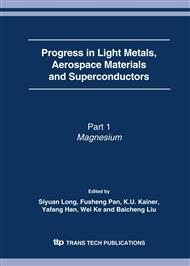p.729
p.735
p.741
p.745
p.749
p.755
p.761
p.767
p.775
Hot Deformation Behavior of 2519 Al Alloy during Isothermal Compression
Abstract:
The deformation behavior of 2519 aluminum alloy was studied by isothermal compression by Gleeble-1500 simulator in the temperature range from 300 to 450°C under the strain rates of 0.01~10s-1. The results showed that the flow stress was controlled by strain rate and deformation temperature. The flow stress increased with strain rate and decreased with deformation temperature. The flow stress of 2519 aluminum alloy increased with strain and to the constant values at three strain rates of 0.01 s-1,0.1 s-1and1 s-1, indicating the dynamic recovery to occur. The flow stress decreased after a peak value with increase of strain at strain rate 10s-1 and deformation temperature higher than 350°C, showing partly dynamic recrystallization. The flow stress of 2519 aluminum alloy during high temperature deformation can be represented by Zener-Hollomon parameter.
Info:
Periodical:
Pages:
749-754
Citation:
Online since:
May 2007
Authors:
Price:
Сopyright:
© 2007 Trans Tech Publications Ltd. All Rights Reserved
Share:
Citation:


